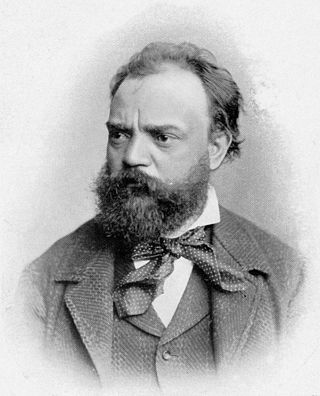
Antonín Leopold Dvořák was a Czech composer. He frequently employed rhythms and other aspects of the folk music of Moravia and his native Bohemia, following the Romantic-era nationalist example of his predecessor Bedřich Smetana. Dvořák's style has been described as "the fullest recreation of a national idiom with that of the symphonic tradition, absorbing folk influences and finding effective ways of using them," and Dvořák has been described as "arguably the most versatile... composer of his time".

Amy Marcy Cheney Beach was an American composer and pianist. She was the first successful American female composer of large-scale art music. Her "Gaelic" Symphony, premiered by the Boston Symphony Orchestra in 1896, was the first symphony composed and published by an American woman. She was one of the first American composers to succeed without the benefit of European training, and one of the most respected and acclaimed American composers of her era. As a pianist, she was acclaimed for concerts she gave featuring her own music in the United States and in Germany.

Roger Huntington Sessions was an American composer, teacher, and writer on music. He had initially started his career writing in a neoclassical style, but gradually moved further towards more complex harmonies and postromanticism, and finally the twelve-tone serialism of the Second Viennese School. Sessions' friendship with Arnold Schoenberg influenced this, but he would modify the technique to develop a unique style involving rows to supply melodic thematic material, while composing the subsidiary parts in a free and dissonant manner.

George Whitefield Chadwick was an American composer. Along with John Knowles Paine, Horatio Parker, Amy Beach, Arthur Foote, and Edward MacDowell, he was a representative composer of what is called the Second New England School of American composers of the late 19th century. Chadwick's works are influenced by the Realist movement in the arts, characterized by a down-to-earth depiction of people's lives.

Egon Joseph Wellesz, CBE, FBA was an Austrian, later British composer, teacher and musicologist, notable particularly in the field of Byzantine music.

Charles Martin Tornov Loeffler was a German-born American violinist and composer.

The String Quartet No. 12 in F major, Op. 96, nicknamed the American Quartet, is the twelfth string quartet composed by Antonín Dvořák. It was written in 1893, during Dvořák's time in the United States. The quartet is one of the most popular in the chamber music repertoire.

Wallingford Constantine Riegger was an American modernist composer and pianist, best known for his orchestral and modern dance music. He was born in Albany, Georgia, but spent most of his career in New York City, helping elevate the status of other American composers such as Charles Ives and Henry Cowell. Riegger is noted for being one of the first American composers to use a form of serialism and the twelve-tone technique.

Arthur William Foote was an American classical composer, and a member of the "Boston Six." The other five were George Whitefield Chadwick, Amy Beach, Edward MacDowell, John Knowles Paine, and Horatio Parker.
William Kroll was an American violinist and composer. His most famous composition is Banjo and Fiddle for violin and piano.
Rudolf Kolisch was a Viennese violinist and leader of string quartets, including the Kolisch Quartet and the Pro Arte Quartet.

Johannes Francis Anton Hekking was a Netherlands-born cellist and teacher.
The String Quintet in E♭ major, Op. 97, B. 180, was composed by Antonín Dvořák during the summer he spent in Spillville, Iowa in 1893. It is a "Viola Quintet" in that it is scored for string quartet with an extra viola. It was completed in just over a month, immediately after he wrote his American String Quartet. Like the Quartet, the Quintet finely captures the inflection of Dvořák's Bohemian idiom with American inspirations. The Quintet was premiered by the Kneisel Quartet in New York on 13 January 1894 along with the second performance of the Quartet and very favorably reviewed, as comparable to Mozart. The reviewer noted that the Quintet was "of the kind about which a commentator may write a small volume without exhausting his admiration or fully describing their beauties".

Kenneth Slowik is an American cellist, viol player, and conductor. Curator of Musical Instrument Collection at the National Museum of American History and Artistic Director of the Smithsonian Chamber Music Society. He took an interest in music and organology from an early age. He studied at the University of Chicago, the Chicago Musical College, the Peabody Conservatory, the Salzburg Mozarteum and, as a Fulbright Scholar, the Vienna Hochschule für Musik, guided by Howard Mayer Brown, Nikolaus Harnoncourt, Antonio Janigro, Edward Lowinsky, and Frederik Prausnitz.

Samuel Gardner was an American composer and violinist of Russian Jewish origin. He won a Pulitzer prize with a string quartet in 1918. He was a student of Franz Kneisel and Percy Goetschius, and began his career as a concert violinist; among his compositions is a violin concerto. He wrote a number of other chamber works, and a handful of things for orchestra, including Broadway, which was performed by the Boston Symphony in the 1929-30 season.
Jean Robert Talbot was a Canadian conductor, violinist, violist, composer, and music educator. For more than 25 years, he was the conductor of the Société symphonique de Québec. A member of the Société française de musicologie, the International Musicological Society, the Musical Association of London, and the Diocesan Commission for Sacred Music, he was the author of several books on music theory. He also contributed music articles to a variety of periodicals.

Karel Ondříček was a Czech violin virtuoso.
Olive Mead (1874–1946) was an American classical violinist. She was a successful soloist and chamber player, performing with Amy Beach, among many others. She formed her own well-regarded string-quartet, the Olive Mead Quartet (1903–1917), which featured only women. Its members were Vera Fonaroff, Gladys North, and Lillian Littlehales. She was a student of Julius Eichberg and Franz Kneisel.

Franz Kneisel was a violinist, conductor, and music teacher.














